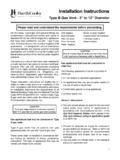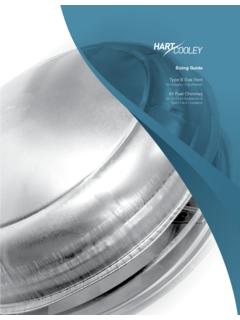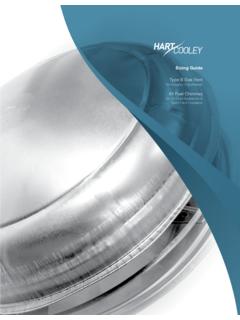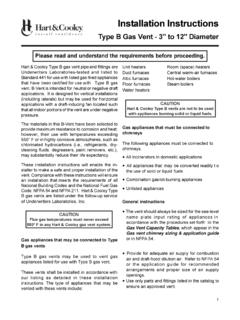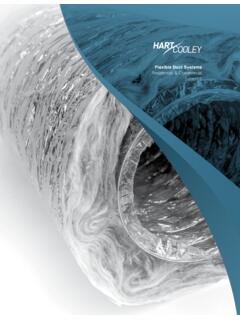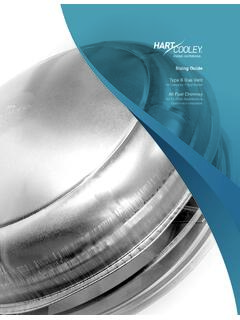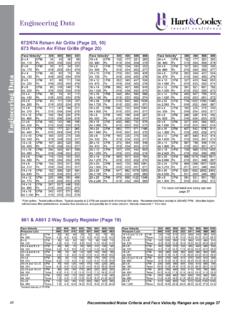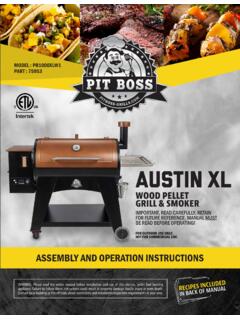Transcription of Sizing Guide - Hart & Cooley
1 Sizing GuideType B Gas Ventfor Category 1 AppliancesAll Fuel Chimneyfor Oil-Fired Appliances & Open-Face FireplacesHart & Cooley5030 Corporate Exchange Blvd. SEGrand Rapids, MI 49512P (800) 433-6341F (800) (800) 433-6341 | 3 Type B Gas Vent Systems Introduction Foreward 4 General Rules 6 Definitions 9 Single-Appliance Vents Procedure 11 Sizing Tables 12 Multiple-Appliance Vents Procedure 15 Sizing Tables 16 Additional Guidelines 19 Multiple-Story Venting Sizing Guidelines 21 System Examples 22 Factory-Built All-Fuel Chimney Systems(includes flexible stainless liner Sizing )
2 Description 26 Sizing Tables 27 Table of Contents4 | Guide is a compilation of the system design and application procedures for all Hart & Cooley Gas Venting and Chimney products. The first section is specifically devoted to the design of Double-Wall Type B Gas Vent Systems for use with equipment certified by the American Gas Association or canadian Gas Guide has been prepared for the convenience and assistance of contractors, building inspectors, engineering firms and architects, as well as for training basis for this Guide is the standard engineering application of the scientific laws for the behavior of fluid flow and heat transfer. In addition, these methods have been proved valid through many decades of field and laboratory experience by engineers, utilities and code Guide SHOULD BE USED IN ADDITION TO, NOT AS REPLACEMENT FOR, HART & Cooley INSTALLATION READ AND COMPLY WITH THE MANU-FACTURER S INSTALLATION INSTRUCTIONS SUPPLIED WITH THE references for the development of the material in this Guide .
3 National Fuel Gas Code, NFPA Standard 54 ANSI for the Installation of Oil-Burning Equipment 2006 Edition, NFPA 31 American Society of Heating, Refrigerating and Air Conditioning Handbook, EquipmentInternational Mechanical CodeThe capacities given in the Tables for Type B Gas Venting are consistent with those found in publications by the appliance manufacturers and NFPA 54 National Fuel Gas capacities given in Section 2 tables for all-fuel chimney are consistent with those found in NFPA 31, Standard for Oil-Burning information on products for use with the systems in this Guide , refer to specific product | (800) 433-6341 | 5 Type B Gas Vent SystemsSingle-Appliance Vents Multiple-Appliance Vents Multiple-Story Venting6 | RulesSystemsThe Tables given in Section 1 apply to system design using Hart & Cooley Type B Gas Vents and to Model TLC Chimneys when used for the venting of listed Category I gas-fired, draft-hood-equipped or fan-assisted combustion appliances.
4 At no time should a venting system for a listed Category II, III, or IV appliance be sized with these tables; instead, follow the appliance manufacturer s B Gas Vent is designed for negative pressure applications and flue gas temperatures that do not exceed 400 Degress Fahrenheit above ambient for Category I must provide the proper clearances to combustible materials as specified in the appropriate Underwriters Laboratories Inc. conditions for Listing, as stated in the product catalogs and embossed on the vent pipe. Hart & Cooley systems to be designed using Section 1 of this Guide are shown below with their proper B Hart & Cooley pipe sizes 3 through 24 inches in diameter require 1 inch of airspace clearance throughout the entire length. Pipe sizes 26 - 30 in diameter require 2 of airspace clearance throughout the entire TLC Hart & Cooley chimney sizes 5 through 14 inches in diameter require 2 inches of airspace clearance to combustible Supply For satisfactory performance of appliances in confined spaces and for the venting system, an adequate supply of fresh air must be provided.
5 When proper air supply has been provided for other appliances, such as clothes dryers, range hoods, fireplaces, etc., then the following method as provided by NFPA Standard 54, ANSI will provide the additional air needed for the appliances. The two grilles specified in A, B, C and D of Figure 1 must be installed so that one is at or below the combustion air inlet of the appliance (within 12 from the floor), and the other above the relief opening of the draft hood (within 12 from the ceiling). The minimum dimension of air opening shall be 3 . Any ducting used should have at least the same free area as the grilles permanent opening, commencing within 12 inches of the top of the enclosure, shall be permitted where the equipment has clearances of at least 1 inch from the sides and back and 6 inches from the front of the appliance.
6 The opening shall directly communicate with the outdoors or shall communicate through a vertical or horizontal duct to the outdoors or spaces that freely communicate with the outdoors (see Figure 1, E) and shall have a minimum free area of: A. 1 inch2/3000 Btu/hour of the total input rating of all equipment located in the enclosure, andB. Not less than the sum of the areas of all vent connectors in the confined combination of air supplied from both the indoors and outdoors is also permitted. See NFPA 54 for these provisions. For appliance rooms in multi-story buildings, all air must come from Building CodeShould the local building code differ from recommendations given in this Guide , consult with your building inspector or other local administrative authority. As stated in the Foreword, the information given is based on the latest scientific data, which has been further verified by a long and satisfactory use history.
7 These data and practices given herein will invariably provide better results than practices required by an obsolete for AltitudeThe vent system should always be designed for the sea level nameplate rating (greatest input when unit has modulated input) of the appliance, regardless of the actual derated operating input required by the local VentsThe gas vent Sizing tables are not applicable to outside (exposed) chimneys or vents below the roofline per NFPA 54. A Type B vent lining an exposed masonry chimney is considered to be an enclosed vent system, and these tables may be pipe (stovepipe) is not recommended for use in TYPE B venting systems. Because of the higher heat loss from the flue products, the draft is reduced and condensation can occur. The resulting moisture may corrode the pipe and will likely leak out on the building and contents, causing single-wall connector pipe usage is accepted local practice, the following considerations must be followed:1.
8 Minimum clearance to combustibles is 6 inches instead of the 1 inch required for Hart & Cooley The heat loss is roughly double that for B-Vent, so DO NOT USE IN ANY COLD OR CONCEALED SPACES, AS CONDENSATION WILL RESULT AND LEAD TO VENTING FAILURE AND POSSIBLE OTHER RiseThe immediate vertical height from the flue collar to the first turn (connector rise) will have an important effect on the proper functioning of a venting system. In order for a venting system to prime (for flow up the vent to start), the vent MUST be heated by the flue gases. If it is easier (less resistance) for the flue products to spill out the draft hood relief opening than to flow into the vent, priming can be delayed or prevented altogether. By using all of the vertical height (head room) available (NEVER less than 1 foot), a venting system will usually prime within 8 to 10 seconds.
9 Small increases in connector rise generally have a greater impact on vent capacity than an increase in common vent Cap or TerminationUse only Hart & Cooley companion listed caps orroof assemblies. The capacity and wind resistance depends on the correct termination. Terminations on any factory-built chimney housing or other custom enclosure or chase MUST comply with the instructions for a roof Type RestrictionsThe following are examples of appliances that are NOT to be connected to Type B gas vent. Other appliances not listed may be restricted. Wood, oil, pellet , coal, kerosene, and any other liquid- or solid-fuel appliance. Category 2, 3, and 4 gas-fired appliances including, but are not limited to, high-efficiency furnaces and water heaters, most tankless water heaters, and some unit heaters.
10 Gas-fired clothes dryers, which can create positive pressure and produce lint that can block the vent. Gas incinerators.(800) 433-6341 | 7 ABDECVENTILATION LOUVERS(each end of attic)VENTILATION LOUVERS(each end of attic)VENTILATION LOUVERS(each end of attic)AIR DUCTINLET(terminate 1 ft. above floor)ALTERNATEAIR INLETALTERNATEAIR INLETVENTILATIONLOUVERSFOR UNHEATED CRAWL SPACEAIRSUPPLYOPENINGSAIRSUPPLYOPENINGOU TLETAIR DUCTOUTLET AIRINLET AIROUTLETAIR DUCTINLETAIR DUCTALL AIR FROM INSIDE BUILDINGALL AIR FROM OUTDOORS THROUGHHORIZONTAL DUCTS**ALL AIR FROM VENTILATEDATTIC OR ADJACENT TO EXTERIOR WALLAIR IN FROM CRAWL SPACE, OUT INTO ATTICSINGLE OPENING, ALL AIR FROM OUTDOORSFree Area ofEach GrilleTotal Input*1000=Free Area ofEach GrilleTotal Input*4000=Free Area ofEach DuctTotal Input*2000=Free Area ofEach Ductor GrilleTotal Input*4000=(Use 2 grilles facing into large interior room.)
